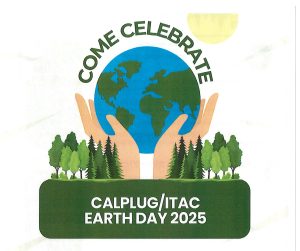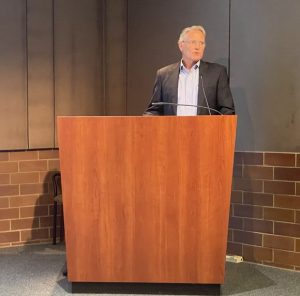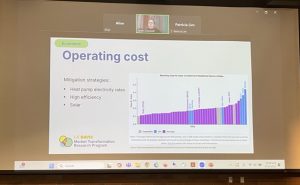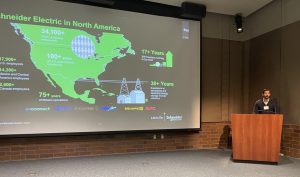Earth Day Workshop Focuses on Clean Energy Efficiency Solutions
April 29, 2025
 From heat pump adoption to clean hydrogen to net zero energy accessory dwelling units, the CalPlug/ITAC Earth Day workshop ran the gamut of energy efficiency solutions. The April 22 event grabbed the interest of 60 plus registrants with interactions between the speakers and audience members.
From heat pump adoption to clean hydrogen to net zero energy accessory dwelling units, the CalPlug/ITAC Earth Day workshop ran the gamut of energy efficiency solutions. The April 22 event grabbed the interest of 60 plus registrants with interactions between the speakers and audience members.
Sarah Outcault is the market transformation research director at the UC Davis Energy and Efficiency Institute and Western Cooling Efficiency Center. She opened the morning workshop session by discussing the barriers to breakthroughs for accelerating heat pump adoption in California.
“California is seriously lagging in heat pump adoption,” Outcault explained. “Air-source heat pumps in residential settings are most prolific in the southeastern region of the United States.”
A heat pump is part of a home heating and cooling system and is installed outside the home. Like an air conditioner such as central air, it can cool the home, but it is also capable of providing heat. In cooler months, a heat pump pulls heat from the cold outdoor air and transfers it indoors, and in warmer months, it pulls heat out of indoor air to cool the home. Heat pumps are powered by electricity and do not burn fossil fuels like furnaces do, making them more environmentally friendly.
Outcault studies the intersection of heat pump technology, policy and human behavior to determine the market transformation. She told the audience that barriers to adoption can be categorized in four areas: economic, technical, informational and externalities.
She said that most consumers are concerned about high upfront costs and high operating costs, often discouraged from switching to the technology or not even given the option to consider installing one. “Contractors act like gatekeepers because they are unfamiliar with the product or have a bad impression from 1980s heat pump technology which is now greatly improved.”
Outcault emphasized the importance of providing greater heat pump educational information and utilizing current user testimonials about how pleased they are with the technology.
The morning session also featured three CALIT2 researchers providing updates from the CalPlug and SMART ITAC programs. After a networking lunch, the afternoon session included four speakers covering a range of topics.

Jeffrey Reed is the renewable fuels and energy storage chief scientist at UC Irvine’s Clean Energy Institute.
Jeffrey Reed is the renewable fuels and energy storage chief scientist at UC Irvine’s Clean Energy Institute. He picked up on the morning theme of improving consumer education when it comes to realizing the benefits of clean hydrogen as a clean fuel source that offers significant climate benefits, helping to reduce greenhouse gas emissions.
Reed said clean hydrogen technologies are mature, but barriers to scaling the sector are a big challenge.
“A significant one, in my opinion, is inaccurate information emanating from proponents of alternative technologies,” said Reed. “More effective messaging is needed to realize the potential of clean hydrogen, along with clear and stable policy.”

Pedro Pajares, CEO of H2B2, joined the workshop remotely to give his talk on hydrogen production systems based on water electrolysis.
The next speaker joined the workshop remotely. Pedro Pajares is the CEO of H2B2, a technology company that promotes, develops, finances, designs, integrates, builds, operates and maintains hydrogen production systems based on water electrolysis.
Pajares presented the SoHyCal project, which is managed by H2B2 and represents a significant step forward in the quest for sustainable energy solutions in California. By producing renewable hydrogen through electrolysis powered entirely by renewable energy, the project is paving the way for a cleaner, more sustainable future.
“We produce renewable hydrogen for mobility in California’s Central Valley,” said Pajares. “H2B2 produces the greenest hydrogen in the United States.”
Amir Tabakh is the chief of energy efficiency at the Los Angeles Department of Water and Power. His Team engages industry leaders to develop the next generation of high-efficiency innovations. In 2020, a micro-shelter and housing company based in Oceanside, Calif. approached Tabakh with an idea. Foldum Corp focuses on building easily transportable, cost-effective, civilized housing units for those who need them the most. The company wanted to improve their ADU offerings by making them net zero energy efficient and turned to LADWP for solutions.
“The collaboration has led to several pilot communities of net zero energy efficient accessory dwelling units for low income and homeless population around the LA region,” Tabakh explained, emphasizing that he wants to get more energy efficiency experts involved in this affordable and highly desirable solution.
Rounding out the workshop was Jeff Gill from Schneider Electric, who has dedicated his career to advancing clean energy solutions. Gill discussed the future of energy management in homes by using a distributed energy resource model.
“We are moving into a distributed energy model instead of a centralized Edison model,” Gill said.
Gill walked the audience through LFP battery technology. Lithium Iron Phosphate is a type of lithium-ion battery that uses lithium iron phosphate (LiFePO4) as its cathode material. It’s known for its safety, durability and long lifespan.
“LFP batteries are becoming increasingly popular in energy storage systems,” explained Gill. “LFP battery technology should be in every home today, like seat belts are in every car now.”
The workshop concluded with the speakers doing a 30-minute panel discussion and Q&A session with the audience.
The following are the eight spring 2024 workshop presentations:
01 SOutcault – heat pump
Sarah Outcault, University of California, Davis
02a Arnold – AI + TES
Shuoyu (Arnold) Wang, CalPlug
02b Katie – plug load strategies
Katie Gladych, CalPlug
02c Chelsea – ITAC
Chelsea Choudhary, CALIT2
03 JReed – clean hydrogen
Jeffrey Reed
04 PPajares – SoHyCal
Pedro Pajares
05 ATabakh – microshelters
Amir Tabakh
06 JGill – SE energy mgmt
Jeff Gill
– Shelly Nazarenus

